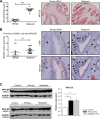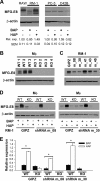Polarization of prostate cancer-associated macrophages is induced by milk fat globule-EGF factor 8 (MFG-E8)-mediated efferocytosis
- PMID: 25006249
- PMCID: PMC4148880
- DOI: 10.1074/jbc.M114.571620
Polarization of prostate cancer-associated macrophages is induced by milk fat globule-EGF factor 8 (MFG-E8)-mediated efferocytosis
Abstract
Tumor cells secrete factors that modulate macrophage activation and polarization into M2 type tumor-associated macrophages, which promote tumor growth, progression, and metastasis. The mechanisms that mediate this polarization are not clear. Macrophages are phagocytic cells that participate in the clearance of apoptotic cells, a process known as efferocytosis. Milk fat globule- EGF factor 8 (MFG-E8) is a bridge protein that facilitates efferocytosis and is associated with suppression of proinflammatory responses. This study investigated the hypothesis that MFG-E8-mediated efferocytosis promotes M2 polarization. Tissue and serum exosomes from prostate cancer patients presented higher levels of MFG-E8 compared with controls, a novel finding in human prostate cancer. Coculture of macrophages with apoptotic cancer cells increased efferocytosis, elevated MFG-E8 protein expression levels, and induced macrophage polarization into an alternatively activated M2 phenotype. Administration of antibody against MFG-E8 significantly attenuated the increase in M2 polarization. Inhibition of STAT3 phosphorylation using the inhibitor Stattic decreased efferocytosis and M2 macrophage polarization in vitro, with a correlating increase in SOCS3 protein expression. Moreover, MFG-E8 knockdown tumor cells cultured with wild-type or MFG-E8-deficient macrophages resulted in increased SOCS3 expression with decreased STAT3 activation. This suggests that SOCS3 and phospho-STAT3 act in an inversely dependent manner when stimulated by MFG-E8 and efferocytosis. These results uncover a unique role of efferocytosis via MFG-E8 as a mechanism for macrophage polarization into tumor-promoting M2 cells.
Keywords: Alternative Activation; Bone; Bone Marrow; Efferocytosis; MFG-E8; Macrophage; Phagocytosis; Prostate Cancer; Skeletal Metastasis; Tumor-associated Macrophages.
© 2014 by The American Society for Biochemistry and Molecular Biology, Inc.
Figures








Similar articles
-
MFG-E8 and HMGB1 are involved in the mechanism underlying alcohol-induced impairment of macrophage efferocytosis.Mol Med. 2013 Jul 24;19(1):170-82. doi: 10.2119/molmed.2012.00260. Mol Med. 2013. PMID: 23552724 Free PMC article.
-
Knockdown of milk-fat globule EGF factor-8 suppresses glioma progression in GL261 glioma cells by repressing microglial M2 polarization.J Cell Physiol. 2020 Nov;235(11):8679-8690. doi: 10.1002/jcp.29712. Epub 2020 Apr 23. J Cell Physiol. 2020. PMID: 32324268
-
MFG-E8 promotes tendon-bone healing by regualting macrophage efferocytosis and M2 polarization after anterior cruciate ligament reconstruction.J Orthop Translat. 2022 May 11;34:11-21. doi: 10.1016/j.jot.2022.04.002. eCollection 2022 May. J Orthop Translat. 2022. PMID: 35615640 Free PMC article.
-
MFG-E8-dependent clearance of apoptotic cells, and autoimmunity caused by its failure.Curr Dir Autoimmun. 2006;9:162-72. doi: 10.1159/000090780. Curr Dir Autoimmun. 2006. PMID: 16394660 Review.
-
Review: milk fat globule-EGF factor 8 expression, function and plausible signal transduction in resolving inflammation.Apoptosis. 2011 Nov;16(11):1077-86. doi: 10.1007/s10495-011-0630-0. Apoptosis. 2011. PMID: 21901532 Review.
Cited by
-
Efferocytosis and Its Role in Inflammatory Disorders.Front Cell Dev Biol. 2022 Feb 25;10:839248. doi: 10.3389/fcell.2022.839248. eCollection 2022. Front Cell Dev Biol. 2022. PMID: 35281078 Free PMC article. Review.
-
Transcriptional Repression by FoxM1 Suppresses Tumor Differentiation and Promotes Metastasis of Breast Cancer.Cancer Res. 2022 Jul 5;82(13):2458-2471. doi: 10.1158/0008-5472.CAN-22-0410. Cancer Res. 2022. PMID: 35583996 Free PMC article.
-
Stromal heterogeneity may explain increased incidence of metaplastic breast cancer in women of African descent.Nat Commun. 2023 Sep 14;14(1):5683. doi: 10.1038/s41467-023-41473-6. Nat Commun. 2023. PMID: 37709737 Free PMC article.
-
The Prognosis of Cancer Depends on the Interplay of Autophagy, Apoptosis, and Anoikis within the Tumor Microenvironment.Cell Biochem Biophys. 2023 Dec;81(4):621-658. doi: 10.1007/s12013-023-01179-4. Epub 2023 Oct 3. Cell Biochem Biophys. 2023. PMID: 37787970 Review.
-
Consequence of alcohol intoxication-mediated efferocytosis impairment.Front Immunol. 2024 Jul 22;15:1386658. doi: 10.3389/fimmu.2024.1386658. eCollection 2024. Front Immunol. 2024. PMID: 39104537 Free PMC article. Review.
References
-
- Bubendorf L., Schöpfer A., Wagner U., Sauter G., Moch H., Willi N., Gasser T. C., Mihatsch M. J. (2000) Metastatic patterns of prostate cancer: an autopsy study of 1,589 patients. Hum. Pathol. 31, 578–583 - PubMed
-
- Loberg R. D., Gayed B. A., Olson K. B., Pienta K. J. (2005) A paradigm for the treatment of prostate cancer bone metastases based on an understanding of tumor cell-microenvironment interactions. J. Cell. Biochem. 96, 439–446 - PubMed
Publication types
MeSH terms
Substances
Grants and funding
LinkOut - more resources
Full Text Sources
Other Literature Sources
Medical
Molecular Biology Databases
Miscellaneous

